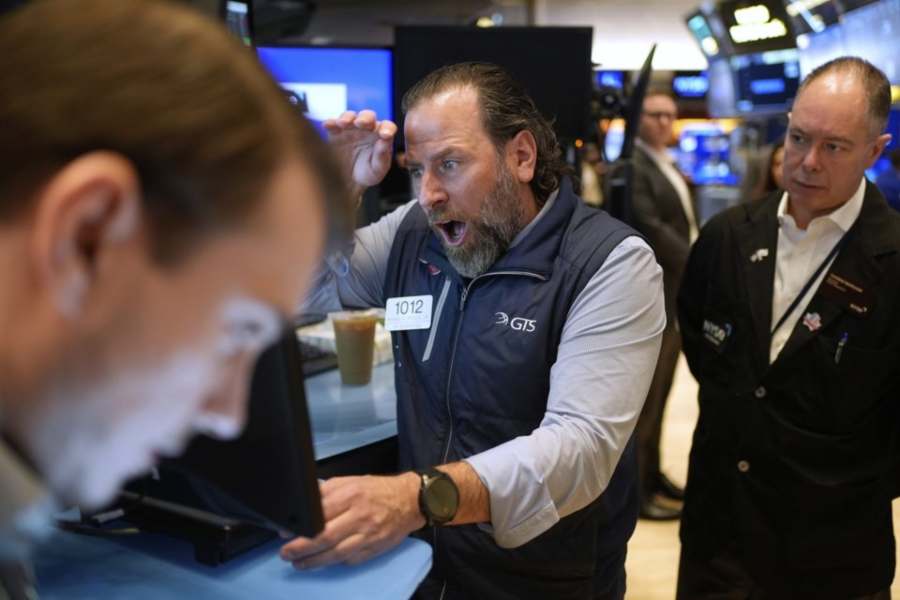In a stunning turn of events reminiscent of the COVID-19 market crash, U.S. stocks plummeted Thursday following President Donald Trump’s unexpected announcement of sweeping new tariffs. The Dow Jones Industrial Average nosedived by 1,679 points, or 4%, closing at 40,545.93. The S&P 500 dropped 4.8%—its worst day since 2020—while the tech-heavy Nasdaq collapsed 6%.
The rout extended far beyond Wall Street. European markets saw France’s CAC 40 lose 3.3% and Germany’s DAX drop 3%. In Asia, Japan’s Nikkei 225 fell 2.8%, Hong Kong’s Hang Seng dipped 1.5%, and South Korea’s Kospi slid 0.8%.
At the heart of the panic were new tariffs announced late Wednesday. The administration revealed a minimum 10% tariff on all imports, with steeper rates targeting products from China and the European Union. UBS economists estimate the measures could trim U.S. GDP by two percentage points and push inflation close to 5%.
“Markets may actually be underreacting,” warned Sean Sun, portfolio manager at Thornburg Investment Management. “If these rates remain, global trade and consumption could suffer serious setbacks.”
The scale of the sell-off evoked memories of the COVID-era crash. Investors fled nearly all assets, dragging down everything from Big Tech to crude oil. Even gold—typically a safe haven—declined. Small-cap stocks took some of the heaviest blows, with the Russell 2000 index plunging 6.6% into bear market territory.
“This is the biggest market shock since COVID,” said Mary Ann Bartels, chief investment officer at Sanctuary Wealth. “Only this time, it’s driven by policy, not a virus.”
Despite the financial chaos, President Trump remained optimistic. Before departing for Florida, he addressed reporters outside the White House, saying, “The markets are going to boom, the stock is going to boom, and the country is going to boom.”
Later, comparing the situation to a medical procedure, he remarked, “We have an operation, like when a patient gets operated on and it’s a big thing. I said this would exactly be the way it is.”
The president’s comments contrasted sharply with Wall Street’s reaction. Many analysts had expected Trump to use tariffs as a negotiating strategy, not as a core policy.
“This isn’t poker anymore,” said Bhanu Baweja of UBS. “These moves signal long-term policy, and markets are pricing in the economic hit.”
The S&P 500 is now 11.8% below its February peak, and analysts warn that deeper declines may be needed to reflect the expected drop in corporate earnings. Companies dependent on global supply chains were hit hardest.
Best Buy shares plummeted 17.8% amid fears of rising import costs. Target lost 10.9%, and United Airlines dropped 15.6%, as consumers and businesses brace for reduced discretionary spending.
Bond markets hinted at possible Federal Reserve intervention. The yield on the 10-year Treasury fell to 4.04% from 4.20% a day earlier, stoking speculation of interest rate cuts.
However, the Fed may face limited options. Lowering rates could stimulate spending, but with inflation pressures rising due to tariffs, doing so exacerbates the problem.
“The Fed is walking a tightrope,” said Jenna Lawrence, senior economist. “They need to balance inflation risks with the growing threat of economic stagnation.”
Despite the turmoil, recent data show the U.S. economy has yet to tip into recession territory. Unemployment claims remained low, suggesting continued labor market resilience. A separate report showed modest growth in the service sector, although weaker than expected.
Still, businesses expressed concern about rising costs and global uncertainty. Many cited the tariffs as a looming headwind, likely to weigh on future investment decisions.
The widespread sell-off reflects broader concerns about how protectionist policies might disrupt global trade. Trump’s remarks focused on bringing manufacturing jobs back to the U.S.—a goal that economists say will require years to achieve, if at all.
“Markets crave clarity,” said Bartels. “A sudden shift in trade policy without clear direction creates instability.”
Investors now await further moves. Will additional tariffs be levied? How will affected countries respond? Will the Fed intervene to stabilize markets?
Until these questions are answered, market volatility may persist. As with past shocks, the next few weeks could determine whether this was a temporary tremor or the start of a more prolonged downturn.
As traders brace for further turbulence, one thing is clear: Trump’s aggressive tariff move has sent a seismic jolt through financial markets worldwide, with echoes of 2020’s darkest economic days.
